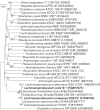Lachnoanaerobaculum gen. nov., a new genus in the Lachnospiraceae: characterization of Lachnoanaerobaculum umeaense gen. nov., sp. nov., isolated from the human small intestine, and Lachnoanaerobaculum orale sp. nov., isolated from saliva, and reclassification of Eubacterium saburreum (Prevot 1966) Holdeman and Moore 1970 as Lachnoanaerobaculum saburreum comb. nov
- PMID: 22228654
- PMCID: PMC3541798
- DOI: 10.1099/ijs.0.033613-0
Lachnoanaerobaculum gen. nov., a new genus in the Lachnospiraceae: characterization of Lachnoanaerobaculum umeaense gen. nov., sp. nov., isolated from the human small intestine, and Lachnoanaerobaculum orale sp. nov., isolated from saliva, and reclassification of Eubacterium saburreum (Prevot 1966) Holdeman and Moore 1970 as Lachnoanaerobaculum saburreum comb. nov
Abstract
Two novel obligately anaerobic, Gram-stain-positive, saccharolytic and non-proteolytic spore-forming bacilli (strains CD3:22(T) and N1(T)) are described. Strain CD3:22(T) was isolated from a biopsy of the small intestine of a child with coeliac disease, and strain N1(T) from the saliva of a healthy young man. The cells of both strains were observed to be filamentous, approximately 5 to >20 µm long, some of them curving and with swellings. The novel organisms produced H(2)S, NH(3), butyric acid and acetic acid as major metabolic end products. Phylogenetic analyses, based on comparative 16S rRNA gene sequencing, revealed close relationships (98% sequence similarity) between the two isolates, as well as the type strain of Eubacterium saburreum and four other Lachnospiraceae bacterium-/E. saburreum-like organisms. This group of bacteria were clearly different from any of the 19 known genera in the family Lachnospiraceae. While Eubacterium species are reported to be non-spore-forming, reanalysis of E. saburreum CCUG 28089(T) confirmed that the bacterium is indeed able to form spores. Based on 16S rRNA gene sequencing, phenotypic and biochemical properties, strains CD3:22(T) and N1(T) represent novel species of a new and distinct genus, named Lachnoanaerobaculum gen. nov., in the family Lachnospiraceae [within the order Clostridiales, class Clostridia, phylum Firmicutes]. Strain CD3:22(T) (=CCUG 58757(T) =DSM 23576(T)) is the type strain of the type species, Lachnoanaerobaculum umeaense gen. nov., sp. nov., of the proposed new genus. Strain N1(T) (=CCUG 60305(T)=DSM 24553(T)) is the type strain of Lachnoanaerobaculum orale sp. nov. Moreover, Eubacterium saburreum is reclassified as Lachnoanaerobaculum saburreum comb. nov. (type strain CCUG 28089(T) =ATCC 33271(T) =CIP 105341(T) =DSM 3986(T) =JCM 11021(T) =VPI 11763(T)).
Figures

Similar articles
-
Faecalicoccus acidiformans gen. nov., sp. nov., isolated from the chicken caecum, and reclassification of Streptococcus pleomorphus (Barnes et al. 1977), Eubacterium biforme (Eggerth 1935) and Eubacterium cylindroides (Cato et al. 1974) as Faecalicoccus pleomorphus comb. nov., Holdemanella biformis gen. nov., comb. nov. and Faecalitalea cylindroides gen. nov., comb. nov., respectively, within the family Erysipelotrichaceae.Int J Syst Evol Microbiol. 2014 Nov;64(Pt 11):3877-3884. doi: 10.1099/ijs.0.064626-0. Epub 2014 Sep 1. Int J Syst Evol Microbiol. 2014. PMID: 25180093
-
Characterization of Lachnoanaerobaculum sanguinis sp. nov., isolated from a blood culture of an acute myeloid leukemia patient with chemotherapy-related bacteremia.Anaerobe. 2025 Jun;93:102961. doi: 10.1016/j.anaerobe.2025.102961. Epub 2025 Apr 14. Anaerobe. 2025. PMID: 40233837
-
Faecalimonas umbilicata gen. nov., sp. nov., isolated from human faeces, and reclassification of Eubacterium contortum, Eubacterium fissicatena and Clostridium oroticum as Faecalicatena contorta gen. nov., comb. nov., Faecalicatena fissicatena comb. nov. and Faecalicatena orotica comb. nov.Int J Syst Evol Microbiol. 2017 May;67(5):1219-1227. doi: 10.1099/ijsem.0.001790. Epub 2017 May 30. Int J Syst Evol Microbiol. 2017. PMID: 28556772
-
Bacteremia due to Lachnoanaerobaculum umeaense in a patient with acute myeloid leukemia during chemotherapy: A case report, and a review of the literature.J Infect Chemother. 2024 Sep;30(9):912-916. doi: 10.1016/j.jiac.2024.02.003. Epub 2024 Feb 8. J Infect Chemother. 2024. PMID: 38336170 Review.
-
Gut microbes from the phylogenetically diverse genus Eubacterium and their various contributions to gut health.Gut Microbes. 2020 Nov 9;12(1):1802866. doi: 10.1080/19490976.2020.1802866. Gut Microbes. 2020. PMID: 32835590 Free PMC article. Review.
Cited by
-
Intestinal T-cell responses in celiac disease - impact of celiac disease associated bacteria.PLoS One. 2013;8(1):e53414. doi: 10.1371/journal.pone.0053414. Epub 2013 Jan 9. PLoS One. 2013. PMID: 23326425 Free PMC article.
-
What's in a Name? New Bacterial Species and Changes to Taxonomic Status from 2012 through 2015.J Clin Microbiol. 2016 Dec 28;55(1):24-42. doi: 10.1128/JCM.01379-16. Print 2017 Jan. J Clin Microbiol. 2016. PMID: 27795334 Free PMC article. Review.
-
Paenibacillus oralis sp. nov., Isolated from Human Subgingival Dental Plaque of Gingivitis Lesion.Curr Microbiol. 2020 Mar;77(3):509-515. doi: 10.1007/s00284-019-01843-0. Epub 2019 Dec 12. Curr Microbiol. 2020. PMID: 31832844
-
Influence of Factors Altering Gastric Microbiota on Bariatric Surgery Metabolic Outcomes.Microbiol Spectr. 2021 Dec 22;9(3):e0053521. doi: 10.1128/Spectrum.00535-21. Epub 2021 Nov 17. Microbiol Spectr. 2021. PMID: 34787463 Free PMC article.
-
Targeting the succinate receptor effectively inhibits periodontitis.Cell Rep. 2022 Sep 20;40(12):111389. doi: 10.1016/j.celrep.2022.111389. Cell Rep. 2022. PMID: 36130514 Free PMC article.
References
-
- Collins M. D., Lawson P. A., Willems A., Cordoba J. J., Fernandez-Garayzabal J., Garcia P., Cai J., Hippe H., Farrow J. A. E. (1994). The phylogeny of the genus Clostridium: proposal of five new genera and eleven new species combinations. Int J Syst Bacteriol 44, 812–826 10.1099/00207713-44-4-812 - DOI - PubMed
-
- Holdeman L. V., Moore W. E. C. (1970). Eubacterium. In Outline of Clinical Methods in Anaerobic Bacteriology, 2nd revision, pp. 23–30 Edited by Cato E. P., Cummings C. S., Holdeman L. V., Johnsson J. L., Moore W. E. C., Smibert R. M., Smith L. D. S. Blacksburg, VA: Virginia Polytechnic Institute Anaerobe Laboratory
Publication types
MeSH terms
Substances
Associated data
- Actions
- Actions
LinkOut - more resources
Full Text Sources
Other Literature Sources
Molecular Biology Databases

